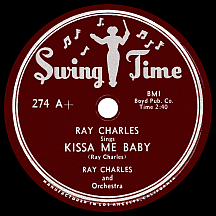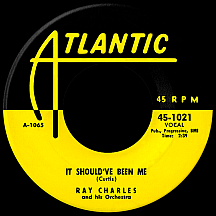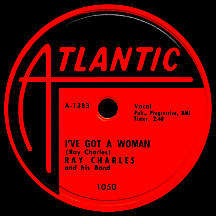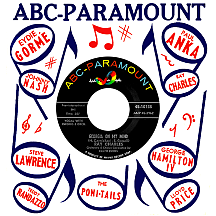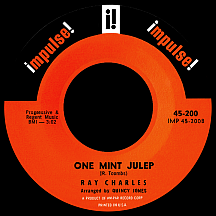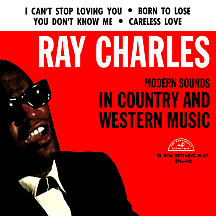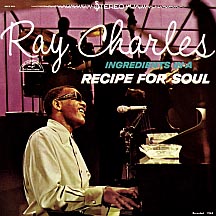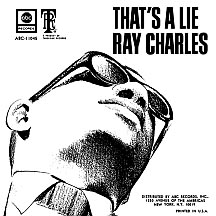RAY CHARLES
What would the world be like if Ray Charles had never existed? I suppose it would be about the same as it is, except for a huge void larger than any one man should leave. His music touched all bases, exceptionally so in nearly every case, while a uniquely individual personality shone through. The jubilant musical praises he was exposed to in church served as a starting point; as he gradually, tragically lost his eyesight between the ages of five and seven, music became top priority ("From the moment I learned that there were piano keys to be mashed, I started mashin' 'em, trying to make sounds out of feelings," he once said). When his sight left him completely, he learned to read in braille quite quickly, which included teaching himself to read music by touch, beginning with the classic works of Beethoven, Mozart and others. Country music held a fascination for the youngster, the live radio broadcasts of the Grand Ole Opry a must-listen every Saturday night; blues, jazz, big band and pop music sparked his interest in ways a person with 20/20 vision might overlook. Ray simply (and fortunately) didn't know any better. Throughout his life he rejected categorization, defying expectations on a regular basis. The sum of all these parts is that he was, quite possibly, the most versatile singer and musician of the 20th century.
Albany, Georgia was the birthplace of Ray Charles Robinson, in 1930 during the heart of the depression. His family moved to Greenville, Florida during his infancy. He witnessed his younger brother, George Robinson, drown in a bathtub, a devastating image he carried with him long after losing his sight. His father departed soon afterwards and his mother died when he was 15, at which point his interest in music was the only thing that mattered. It became his way of creating a world he couldn't see, a world made up entirely of sounds. He'd attended the St. Augustine school for the blind, deaf and dumb, as they called it then, baffled by the segregation within the state-run school's system ("Imagine separating kids according to color when we couldn't even see each other!"), but quit after his mother's passing, moving to Jacksonville to explore his chances of making a living as a musician. Starting in 1945, he played piano in small jazz bands and spent time with an otherwise all-white country group called The Florida Playboys.
Much of his musical output maintained a spiritual essence, his earliest preference due simply to the fact that it was the first music he heard, yet heads of churches often criticized him for making gospel music sound worldly (a burden one must accept, I suppose, when pursuing a secular career that draws upon every possible influence and weaves musical genres together). With little happening in Florida, Ray moved to Seattle, Washington in 1948. He met bandleader "Bumps" Blackwell and trumpeter Quincy Jones, who at 15 was three years Ray's junior. The three played together for a short time before Ray, guitarist Gosady McKee (who'd worked with him in Florida) and bassist Milt Garred formed The McSon Trio (the name an amalgam of McKee and Robinson).
Jack Lauderdale, owner of the recently-established Down Beat Records, caught one of the McSon Trio's shows and made a contract offer. Ray didn't bother to quibble about how much money he would make: "I didn't care, I would have done it for nothin'!" "Confession Blues" was cut in a Seattle studio with Ray taking his best shot at doing a Nat "King" Cole impression (he had an obsession with Cole, intrigued by the singer's ability to do what few black men could in the 1940s: make music that appealed to all kinds of people, not just the negro community). The record, mistakenly credited to The Maxin Trio, was a hit (top ten on the Race/Rhythm and Blues charts in the spring of 1949), an impressive feat (or stroke of luck) for a first-time recording act. Lauderdale (who was also having success with emerging bluesman Lowell Fulson) changed the label's name due to pressure from Chicago's Down Beat Magazine, first to Swing (a further misspelled Maxim Trio 78 came out on that label) and later to Swing Time. Ray made a change, too, permanently taking the name Ray Charles in order to avoid confusion with the current welterweight (later middleweight) boxing champ Sugar Ray Robinson.
Ray and the group moved to Los Angeles and continued making records in the jazz-and-pop realm that Cole had been so successful in; records began appearing under Ray's name in 1950 (a transitional disc on Swing, "I've Had My Fun," was credited to the Ray Charles Trio) and sometimes featured other musicians including King Cole Trio guitarist Oscar Moore! "Baby Let Me Hold Your Hand" had a sound similar to Charles Brown and reached the national R&B charts in February 1951. Top ten hit "Kissa Me Baby," on the other hand, blasted from speakers with a big band arrangement and a suggestive '...all night long' refrain that made it one of the hottest tracks of 1952. "Kissa Me" had more of what eventually evolved into Ray's own personal sound, but at that still-early stage he wasn't quite ready to cut loose 100 percent, possessing a nagging self-consciousness about whether people would accept him just as he was.
Lauderdale, in a cost-cutting move, offered Ray's contract to anyone who might be interested. During this brief time in 1952, Ray cut four sides for the Sittin' In With label and two for the small Rockin' Records. Meanwhile, Ahmet Ertegun and Herb Abramson caught wind of the offer and signed him for 2,500 bucks, a bargain for Atlantic Records that wasn't immediately evident. Jesse Stone did the arranging for Ray's first batch of recordings at Atlantic's New York studios in September 1952; inaugural single "Roll With My Baby" was perhaps the closest imitation of Nat Cole yet, indicating an artist unsure of what was expected of him in his new surroundings. A second round eight months later with crack players like guitarist Mickey Baker, saxophonists Freddie Mitchell and Dave McRae and bassist Lloyd Trotman yielded stronger results. "Mess Around," penned by Ertegun using his nom de plume Nugetre, lifted its intro from the piano riff of Cow Cow Davenport's 1928 recording "Cow Cow Boogie," then launched into a wild, rocking party song with lyrics like '...everybody was juiced, you can bet your soul...they did the boogie woogie with a steady roll!' One of Ray's greatest moments...and it still wasn't a hit. What?
"It Should've Been Me," a clever scenario created by Memphis Curtis (who'd written The Clovers' hit "Lovey Dovey"), was recorded the same day. It used a talking line-of-bull that would become a mainstay of Charles' recordings throughout the years: 'A little later on, a theater I passed...I spotted another chick, and did she have class...I was all set to write her name in my book...when her husband came up and gave me a real dirty look!' (singing) 'It should've been me...with that real fine chick...' Ray's ghetto-relatable story of frustration achieved its rightful place in the R&B top ten in April 1954. As Ertegun and company loosened the reins, Ray became more comfortable, ultimately calling all the shots and taking control of his fate. It was the right way to go.
Ray made several recordings in New Orleans in the latter half of 1953, then spent most of '54 on the road. While in Texas, he put together a band that included saxophonist David "Fathead" Newman and trumpeter Renald Richard, both regular contributors to the Charles sound over the next few years. He also began producing his own sessions (despite being credited as producers on his recordings, Ertegun and Jerry Wexler basically stood back and let Ray do his thing). He made a stop in Atlanta late in the year, laying down some mean tracks at radio station WGST including "I've Got a Woman," his vocals at their peak, tossing out lyrics that reveal a 1950s male-dominant mindset ('She's there to love me, both day and night...never grumbles or fusses, always treats me right...never runnin' in the streets, and leavin' me alone...she knows a woman's place is right there now in her home'), an attitude that would certainly stir up more controversy now than then. The song broke Ray into the pop market in early 1955, its timing having as much as anything to do with the record's success, as black artists and smaller independent record companies began to pull the rug out from under the major labels...and rock and roll gradually emerged as a force to be reckoned with.
One of my favorite quotes from Ray Charles sums up how he felt about his music: "When I do a song, I like to make it stink in my own way!"...and man, did he ever put his own kinda nastiness on just about everything he did! From the beginning, he refused to be classified as rhythm and blues, jazz or, later, rock and roll, insisting his music was whatever he himself wanted it to be. This attitude became clearer as time went by and Ray further stretched his boundaries beyond genres. After "I've Got a Woman," he enjoyed hit after hit with self-penned pleasures like the bluesy "A Fool For You" and its joyous flip, "This Little Girl of Mine," "Blackjack" ('...how unlucky can one man be?') and its flip "Greenbacks," Renald Richard's essay on how a man can sometimes lose his hard-earned cash to a wiley woman ('I left the place with tears in my eyes...as I waved Lincoln and Jackson a last goodbye!').
He began hiring female singers to liven up the proceedings. Mary Ann Fisher tickled Ray's fancy, as a singer and in his personal life (rumor is she's the subject of "Mary Ann"...makes sense!); she later had a minor hit solo single, "I Can't Take It," on the Seg-Way label. Atlantic girl group The Cookies (they first recorded for the Aladdin subsidiary Lamp in '54 and had a hit, "In Paradise," on Atlantic in early '56) were brought into the fold; Margie Hendrix, Darlene McCrae and Pat Lyles, along with Mary Ann, became The Raelets, a backing group carrying Ray's name (sort of) that later had many changes to its lineup. The hits kept coming: "Drown in My Own Tears," written by Ray with Henry Glover, perfectly set a maudlin mood. "Hallelujah I Love Her So" raised churchgoers' eyebrows yet again with its mixture of a gospel sound and vulgarity ('She kisses me and she hold me tight...and tell me Daddy everything's all right!'). Doc Pomus's "Lonely Avenue" is superbly sad and dreary and "Rockhouse" is nothing less than a smooth jazz tune sans vocal.
Recognizing the exceptional vocal talent of Margie Hendrix, Ray gave her a featured spot on "(Night Time Is) The Right Time," a Nappy Brown jam from 1957 that, with Margie's assertive 'Baby! Oh, baby!!!' interlude, rocked the R&B charts in early '59. The next level was reached with "What'd I Say," improvised by Brother Ray when he had 15 minutes to spare at a performance; he made up the song as he went along and instructed the Raelets to simply repeat what he said: 'It's all right (baby it's all right!)...baby shake that thing (baby shake that thing!)'...suggestively: 'Unnh (unnh!) ohh (ohh!)...make me feel so good (make me feel so good!),' and so on. The reaction from the crowd was over-the-top, and so it went, night after night in different cities. When Ray recorded it (playing a Wurlitzer electric piano, an unusual choice), the song ran very long; it was edited to around five minutes and released as a single with Part I and Part II. A number one R&B hit in August 1959, "What'd" was the first record by Charles to reach the top ten on the pop charts. Ertegun and the gang at Atlantic called him "The Genius," an appropriate nickname.
The youthful Ray Charles who just wanted to play music had developed a taste for the good life (or was it the drugs he regularly indulged in, heroin mainly, that he had to make sure he could afford?). With this came a more savvy business sense; when his Atlantic contract expired in late 1959, he shopped around for a better deal. ABC-Paramount anted up a lot more money and sweetened the pot with the one thing that sealed the deal: after an initial period, he was guaranteed complete ownership of everything he recorded. With apologies to the mostly-good folks at the record company that had made him a star, Ray signed a long-term contract with ABC. First single, "My Baby! (I Love Her, Yes I Do)," failed completely...but why? Too much of the Raelets? Margie had dominated other songs without a problem! Many artists over the years have left their home bases for more lucrative deals, only to flounder upon making the switch. In Ray's case, time was needed for settling in (as with Atlantic, only this time inexperience wasn't a factor). Titus Turner's "Stick and Stones," a strong slice of attitude served up by Ray with a heavy dose of Raelets, made the pop top 40 and number two R&B in the summer of 1960, and he was off and running. The next single, a remake of a 30-year-old Hoagy Carmichael tune, gave Ray a whole new high and became a bona fide classic in the process.
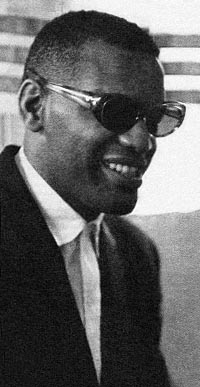
"Georgia on My Mind," penned by Hoagy and Stuart Gorrell, had originally been recorded by Carmichael for Victor Records (as "Georgia (On My Mind)") in 1930. Ray's resurrection of the song baffled many bystanders, what with its sentimental arrangement heavy on strings and a pure pop vocal backing. Music fans were simply captivated (in the state of Georgia, well, it was a quiet kind of pandemonium) and in November 1960 it became Ray's first number one Hot 100 hit. In early '61, he suddenly found himself inside the wacky whirlwind of the Grammy Awards, an honor that has proven over the years to mean little if you just win one...but four Grammys, let's say, that many wins accounts for something. Ray Charles suddenly had five nominations, including a nod for "Georgia" in the top category, Record of the Year. Turns out it was the only award he didn't win the evening of April 12 (Percy Faith's "(Theme from) A Summer Place" took the honor), his four statuettes evenly split between works from former and current record labels; The Genius of Ray Charles won for Best Vocal Performance, Album, Male, and "Let the Good Times Roll" landed him the award for Best Rhythm and Blues Performance (both were Atlantic releases), while "Georgia" scored in the somewhat redundant categories Best Vocal Performance, Pop and Best Vocal Performance, Male. These were the first of an impressive total of 17 Grammys, icing on top of a whole lot of well-deserved mantle hardware handed out for a lifetime of amazing, entertaining output.
According to Ray, "Classical music is a great foundation for playing jazz." And play it he could, though he could also boil it down to a mainstream pop kind of vibe (not a bad thing) as with "One Mint Julep," the Rudy Toombs tune that had been a big hit in '52 for Atlantic's Clovers. Ray's 'Just a little bit of soul, now' instrumental rendering hit the top ten in the spring of 1961, just as he was basking in Grammy's glow. The track was issued on ABC's jazz imprint, Impulse!, as was a great two-sided Charles 45, "I've Got News For You" backed with "I'm Gonna Move to the Outskirts of Town," and an LP, Genius + Soul = Jazz, with arrangements by Ralph Burns and Ray's former teenage pal from his Puget Sound period, Quincy Jones.
About-face! Ray and his Raelets went wild, and hyper-relatable, with the Percy Mayfield sing-along "Hit the Road Jack" ('Well I guess if you say so, I'll have to pack my things and go (That's right!)', a number one hit in October 1961 that later landed him his fifth Grammy win (for Best R&B Recording). A sequel of sorts, "Unchain My Heart" (composed by Bobby Sharp, though credit went to Agnes Jones and Freddy James when Sharp sold the rights), offered a rebuttal ('Why lead me through a life of misery...when you don't care a bag o' beans for me?') and sent Ray back to the top ten. He did his part to spread the word on jazz singer Betty Carter, who'd been in the business well over a decade; a playful duet version of Frank Loesser's "Baby it's Cold Outside" helped spark a resurgence in Carter's career.
He'd dabbled in country music (a jumpin' version of Hank Snow's "I'm Movin' On" hit the top 40 in '59), but Modern Sounds in Country and Western Music...well, this was overdoing it, right? Ray had to remind some of his cohorts that he didn't hold himself to any particular musical boundaries, that he loved C&W (the Grand Ole Opry was still his favorite show!) and besides, he was sure the public would dig it if he walloped them with a dozen country songs all at once. Insanity? Nope. Genius! For the album's single, he chose Don Gibson's underrated four-year-old B side "I Can't Stop Loving You" backed with "Born to Lose," debuted back in '43 by country and western great Ted Daffan using the pen name Frankie Brown. Radio stations and listeners responded immediately; the A side held sway at number one in June 1962 and was the year's biggest hit single (as well as a Grammy winner...Best R&B Recording again, despite its decidedly country lean!) and the flip was a hit in its own right. The follow-up, Cindy Walker and Eddy Arnold's "You Don't Know Me" (which had already done the trick for Arnold, Jerry Vale and Lenny Welch), made it to number two, while the 33 longplay spent more than three months at the top of the album charts, making the choice to record and release Modern Sounds in Country and Western Music Volume Two a no-brainer.
That second volume contained a hit single far removed from the song's original concept; "You Are My Sunshine," a 1940 declaration of love from the pens of Jimmie Davis and Charles Mitchell that is perhaps best known by way of Gene Autry's '41 hit version, surely got the devout crowd riled up over Ray and his Raelets' sexy '62 reworking. The Fred Rose-Hy Heath weeper "Take These Chains From My Heart," made famous by Hank Williams, became yet another top ten for Ray in May 1963. Harlan Howard's "Busted," besides commenting on cotton prices ('...down to a quarter a pound...'), provided Ray with another top ten hit in the fall as well as Grammy number seven, in the same category as the previous two. Despite Ray's resistance to categorical labels, Ingredients in a Recipe For Soul contained a cross section of styles among its ten tracks, including a few more country-based selections.
A show at the Shrine Auditorium in Los Angeles in September 1964 was released under the title Live in Concert and a couple of six minute tracks were culled from the set for singles, each divided into two parts; "Makin' Whoopee" came off as a slightly more literal interpretation of Eddie Cantor's 1928 hit and "I Gotta Woman" (respelling the title of the breakthrough '55 smash) fastened on a bit of Beethoven's "Für Elise" as a prelude. In 1966 Ray was on a Buck Owens kick with hit remakes of the county superstar's "Crying Time" and "Together Again," winning two Grammy awards for the former in oddly identical categories (Rhythm and Blues Recording and Rhythm and Blues Solo Vocal Performance), each duplicating the same five nominees.
A perk for Ray took shape in the form of his own record label, Tangerine, distributed by ABC-Paramount. "Hit the Road Jack" composer Percy Mayfield, who'd been a hitmaking R&B star in the early '50s, had many releases on the label, which began in 1962 and lasted more than ten years. Louis Jordan, Ike and Tina Turner and even garage rockers ? and the Mysterians recorded for Tangerine. The Raelets had several singles on the label starting in 1966, five of which made the R&B charts; group members during this time included Merry Clayton, Gwendolyn Berry, Alexandra Brown, Minnie Riperton, Clydie King and Little Willie John's sister Mabel John.
There really wasn't a lot of confusion regarding the "other" Ray Charles (real name Charles Offenberg), whose Ray Charles Singers enjoyed success in the '50s on Perry Como's variety series and in the '60s as a hitmaking pop act (best-selling single: "Love Me With All Your Heart" in 1964). Ray Charles (Robinson) found humor in the situation; I remember him appearing on The Tonight Show joking about Ray Charles (Offenberg) getting his checks by mistake (he didn't really) and cashing them!
Joking around came easier to Ray in 1966; after many years of addiction to drugs, and a few related arrests kept as quiet from the record-buying public as possible, he entered rehab for the last time and kicked the habit for good. His next single after getting clean? "Let's Go Get Stoned," of course, a song by Valerie Simpson, Nicholas Ashford and Jo Armstead first recorded by The Coasters the previous year. All in good fun, right? A big hit, it brought his initial country phase to an end (for the most part) and kicked off a series of grittier, more soulful offerings, many of them ranking among his best work. "I Chose to Sing the Blues" (he penned it in collaboration with Jimmy Holiday), "I Don't Need No Doctor" (another one from Val, Nick and Jo) and the Quincy Jones-Alan Bergman-Marilyn Bergman theme from the 1967 Oscar-winning Best Picture "In the Heat of the Night," starring Sidney Poitier and Rod Steiger, came during this time.
Artists from all areas of music have done far too many covers of songs by The Beatles to mention, but suffice it to say some were very good while a great many more paled in comparison to the originals. Ray Charles had hits with a couple of John Lennon-Paul McCartney songs and it's really no surprise; "Yesterday" and especially his passionately moody interpretation of "Eleanor Rigby" (the lyrics delivered as if he was personally acquainted with the fictional Father McKenzie) rank among the best Beatles remakes. The flip side of the latter single, "Understanding," is worthy of mention, a positively morbid, Hitchcockian narrative on unstable domestic relationships written by Charles and Holiday and delivered by Ray with chilling enthusiasm.
A 1969 duet with Mississippi-born singer-songwriter Jimmy Lewis, "If it Wasn't For Bad Luck," opened doors for the struggling singer who'd been on the fringe of the music business for several years. Lewis's "If You Were Mine" in 1970, Holiday's "Don't Change on Me" and Ray's funky instrumental "Booty Butt," both hits in 1971, and his dynamic, personalized rendition of "America the Beautiful" are the most popular recordings of what could be called his late hitmaking period. I could go on and on about Ray's post-1960s career, the comebacks, the return to country music, his many, many awards (Grammys and otherwise) and a pop culture presence that remains strong. An extremely popular series of television commercials for Pepsi-Cola in the early '90s had a catchphrase (sung with the help of Darlene Dillinger, Gretchen Palmer and Meilani Paul, known collectively as The Uh-Huh Girls) that answers the question of Ray's rightful place as one of the select few master musicians and superstar singers among the overstuffed legion of 20th and 21st century recording acts. Whenever someone chooses to listen to the music of Ray Charles, it's clear: 'You got the right one, baby...uh-huh!'
NOTABLE SINGLES:
- Confession Blues - 1949
by the Maxin Trio - I've Had My Fun - 1950
as Ray Charles Trio - Baby Let Me Hold Your Hand - 1951
- Kissa Me Baby - 1952
- Roll With My Baby - 1952
- Mess Around - 1953
- Feelin' Sad - 1953
- It Should've Been Me - 1954
- Don't You Know /
Losing Hand - 1954 - I've Got a Woman /
Come Back - 1955 - A Fool For You /
This Little Girl of Mine - 1955 - Blackjack /
Greenbacks - 1955 - Drown in My Own Tears /
Mary Ann - 1956 - Hallelujah I Love Her So - 1956
- Lonely Avenue - 1956
- Ain't That Love - 1957
- Swanee River Rock (Talkin' 'bout That River) - 1957
- Rockhouse (Part 2) - 1958
- (Night Time Is) The Right Time - 1959
- That's Enough - 1959
- What'd I Say - 1959
- I'm Movin' On - 1959
- My Baby! (I Love Her, Yes I Do) - 1960
- Sticks and Stones - 1960
- Tell the Truth - 1960
- Georgia on My Mind - 1960
- Ruby /
Hardhearted Hannah - 1960 - Come Rain or Come Shine - 1960
- Them That Got - 1961
- One Mint Julep - 1961
- I've Got News For You /
I'm Gonna Move to the Outskirts of Town - 1961 - Hit the Road Jack - 1961
- Unchain My Heart /
But on the Other Hand Baby - 1961 - Baby it's Cold Outside - 1962
by Ray Charles and Betty Carter - At the Club /
Hide 'Nor Hair - 1962 - I Can't Stop Loving You /
Born to Lose - 1962 - You Don't Know Me /
Careless Love - 1962 - You Are My Sunshine /
Your Cheating Heart - 1962 - Don't Set Me Free - 1963
- Take These Chains From My Heart - 1963
- No One /
Without Love (There is Nothing) - 1963 - Busted - 1963
- That Lucky Old Sun - 1963
- Baby, Don't You Cry (The New Swingova Rhythm) /
My Heart Cries For You - 1964 - My Baby Don't Dig Me - 1964
- No One to Cry To /
A Tear Fell - 1964 - Smack Dab in the Middle - 1964
- Makin' Whoopee - 1964
- Cry - 1965
- I Gotta Woman - 1965
- Crying Time - 1966
- Together Again /
You're Just About to Lose Your Clown - 1966 - Let's Go Get Stoned - 1966
- I Chose to Sing the Blues - 1966
- Please Say You're Fooling /
I Don't Need No Doctor - 1966 - Here We Go Again - 1967
- In the Heat of the Night - 1967
- Yesterday - 1967
- That's a Lie - 1968
- Eleanor Rigby /
Understanding - 1968 - If it Wasn't For Bad Luck - 1969
by Ray Charles and Jimmy Lewis - If You Were Mine - 1970
- Don't Change on Me - 1971
- Booty Butt - 1971
by the Ray Charles Orchestra - America the Beautiful - 1972


